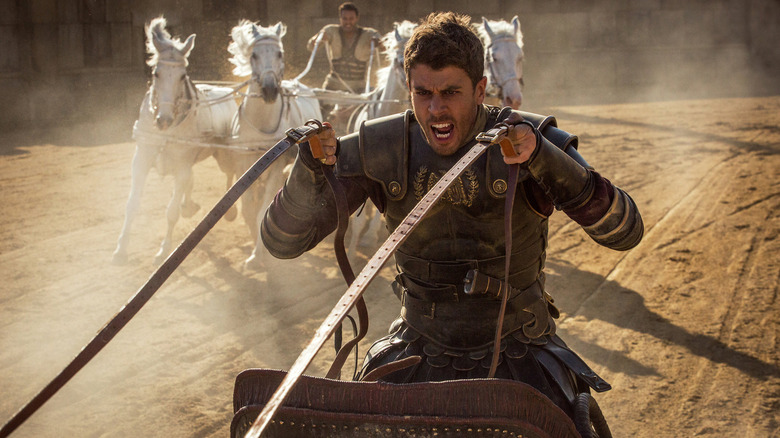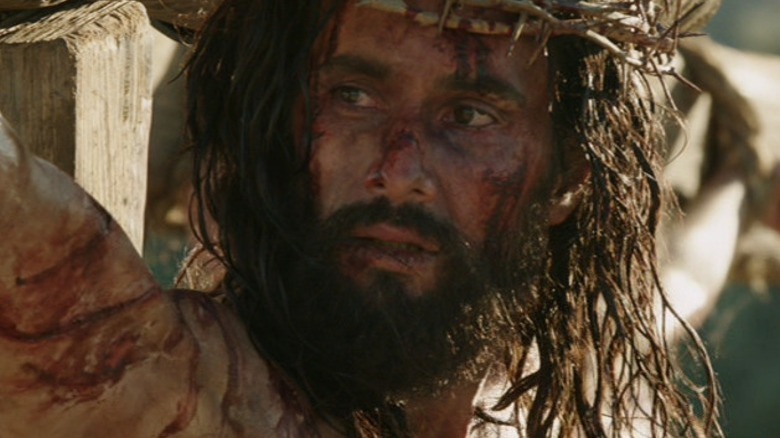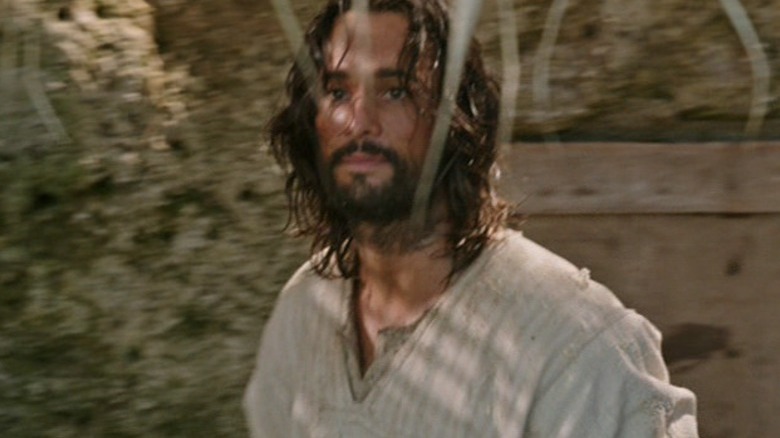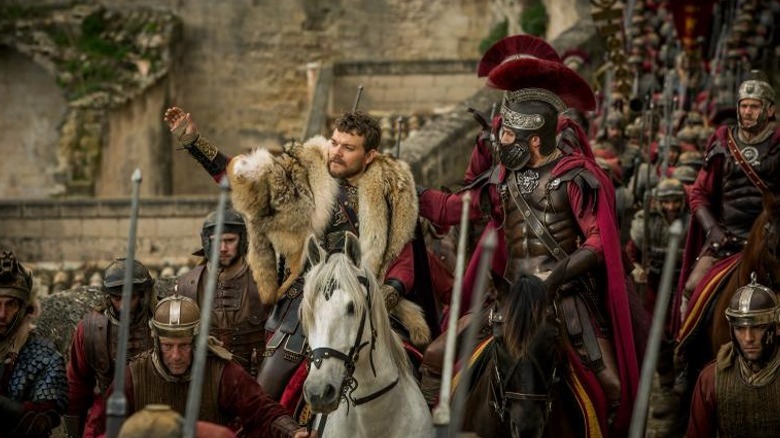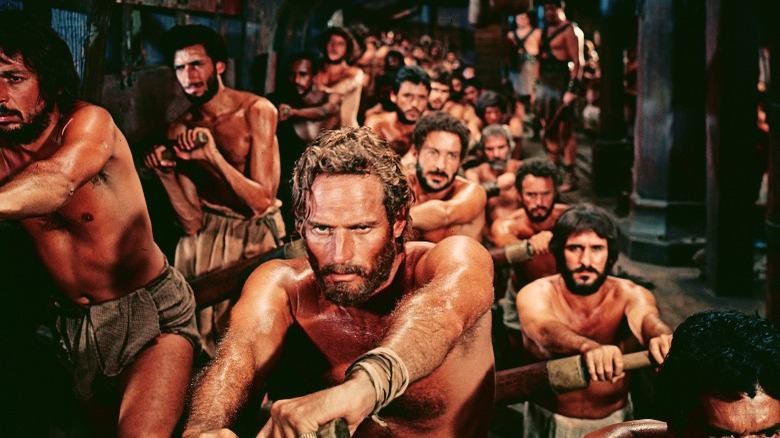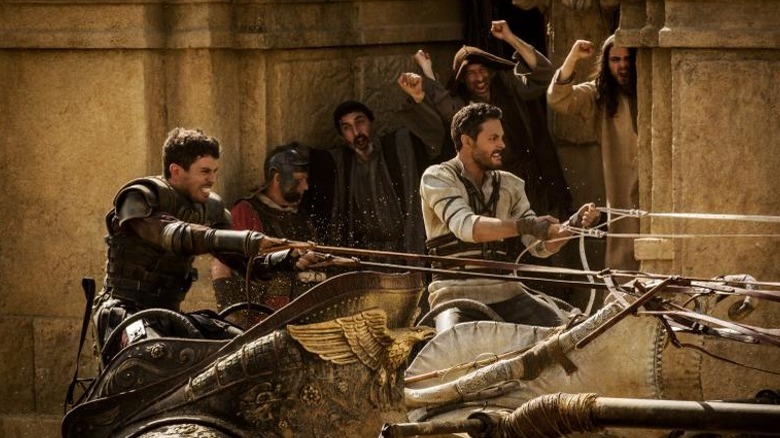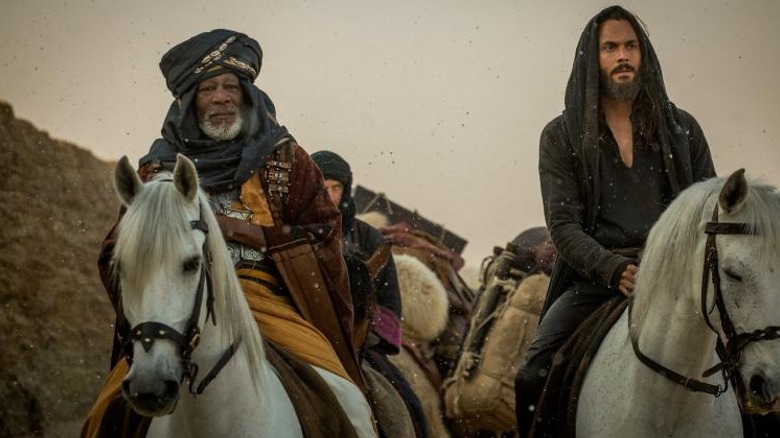Why 2016's Ben-Hur Remake Was A Box Office Flop
Lew Wallace's 1880 novel "Ben-Hur: A Tale of the Christ" has been adapted into film many times. Much like the regular remakes of "A Star is Born," including the 2018 version, every adaptation reveals something about where Hollywood was at the time of its making. The story is a sprawling biblical epic, one that suggests a kind of maximum blockbuster potential, with naval war scenes and gladiatorial combat. Silent adaptations were made in 1909 and 1927, but the most enduring (and human) take on the story was the four-hour 1959 epic directed by William Wyler.
So why did the 2016 take on "Ben-Hur" fail to make any kind of impact — or even its budget back at the box office? It's not as if the story is any less rich in the current day. Positive memories of the definitive Wyler take on the story surely linger. And that story's brand of action and masculine themes, with Ben-Hur's sacrifice and eventual rise as a charioteer, is not dissimilar from any number of superhero origin stories. Director Timur Bekmambetov, known at the time for stylish action movies like "Wanted" and "Abraham Lincoln: Vampire Hunter," was a good fit as well.
Despite the reasons it could have succeeded, it ended up being a flop. The film made just $94 million worldwide on a $100 million budget. When it grossed just $11 million on its opening weekend, it was deemed "disastrous." Certainly not an entirely unsuccessful film, but a bad bet on the part of MGM and Paramount, who produced the movie.
A Tale of the Christ
Despite its splendor and pageantry, Lew Wallace's novel "Ben-Hur" tells a rich and moving story of friendship, a fall from grace, and vengeance. The "Tale of the Christ" subtitle on the book and most of the film versions suggest a religious component, but it's more of a masculine melodrama than anything else.
Two men of the ancient world, the Jewish prince Judah Ben-Hur (Jack Huston) and the Roman officer Messala (Toby Kebbell), are bound by childhood friendship. But as the Roman Empire begins to strengthen its grip on Judea, the two men find their relationship gradually strained by national differences. Soon, they are mortal enemies, as prince Ben-Hur tries to defend the Jewish rebels who are persecuted for fighting back.
He is then imprisoned and enslaved as Messala finds glory in the Roman Imperial ranks. As if destined, the two end up clashing again in a climactic gladiatorial chariot race, one with bloody consequences for both men. Finally, grace is found, not through anything the characters do, but through the crucifixion of Jesus, setting the story securely in the realm of the biblical.
Still, no version of the movie falls totally under the "faith-based" label, even though the 1959 film's relative sense of taste around its depiction of Christ makes it one of the best American religious movies.
The 2016 version of the film is simultaneously more secular than past versions — as it focuses much more on Ben-Hur's journey for revenge and the Jewish struggle against the Roman Empire — and more explicitly religious. The 1959 version of the film depicted Jesus reverently, as a silhouetted figure who never faced the camera head-on. In 2016, he's an active participant.
Jesus is just some guy
Curiously, by incorporating the grassroots rise of Jesus of Nazareth (Rodrigo Santoro, who was given the blessing by Pope Francis) into the human drama of "Ben-Hur," the 2016 movie reduces him to a supporting character in an epic. The 1959 film cast Jesus definitively as a figure of supernatural grace by rarely showing him. Here, he is given just enough to do that he feels like a regular person, but not enough to do that the movie becomes a "faith-based" passion play. His story feels incongruously welded onto Ben-Hur's.
Making movies for an explicitly Christian audience in the 21st century is always a gamble. Whatever money a studio makes from church crowds, they might lose from the general audience. Any movie that seriously explores religion like "First Reformed" or "Silence" is often relegated to an arthouse release, and if you're expecting biblical imagery from a contemporary big-budget studio film, the best you can do is something like "The Batman."
If 2016's "Ben-Hur" emphasized the Jesus connection more in its marketing, it could have drawn more of that churchgoing crowd. Besides one brief shot of the crucifixion in its trailer, there's hardly any suggestion that this movie is "A Tale of the Christ" like the book's previous adaptations. But the marketing accurately reflects the movie, which is ultimately much more concerned with brother against brother: Ben-Hur vs. Messala. It's an action film above everything else. And besides, most faith-based films are made at a relatively low budget compared to "Ben-Hur's" $100 million. 2018's "I Can Only Imagine," for instance, was budgeted at $7 million (and made $83 million off of that).
Twenty-first century spectacle
As a pure biblical epic, the 1959 "Ben-Hur" promised a grand spectacle, the likes of which the movies had never touched before. The movie had thousands of extras, massive production design, and of course, a spectacular chariot race, all wedded to a monumental performance by Charlton Heston as the titular Jewish prince.
By 2016, spectacle and big budgets had effectively taken over the American cinematic landscape, especially on the occasion of the summer release given to "Ben-Hur." Movies on the scale of the 1959 film were being made seemingly every week, mostly in the form of superhero films like "Suicide Squad" or "Captain America: Civil War," but also in sci-fi extravaganzas like "Star Trek: Beyond." "Ben-Hur" frankly needed something to differentiate itself from the pack, and the ancient setting was hardly it. The similarly mounted "Pompeii," from just two years prior to "Ben-Hur," also had a poor showing at the box office, suggesting that the ancient epic genre was hardly capable of setting records anymore.
Still, 2016's "Ben-Hur" has a strong production design, solid visual effects work, and a truly epic scale. The problem is more in the cheap-looking handheld photography employed by Timur Bekmambetov and cinematographer Oliver Wood, and in the choppy pacing that keeps the movie just a bit over two hours. Where the 1959 "Ben-Hur" knew that it could keep an audience gripped for four hours, the 2016 one jumps straight into the action, with an in-media-res prologue set before the chariot race, and narration by none other than Morgan Freeman, who plays Sheik Ilderim.
It's a move that seems to lack confidence.
Comparisons to the original
That lack of confidence becomes a significant issue when comparing the film to its most significant forebear: William Wyler's "Ben-Hur." Wyler staged his film in ultra-widescreen, at an aspect ratio of 2.76:1, and the movie feels massive. But the oblique and poetic dialogue, performed by brilliant actors like Stephen Boyd and Charlton Heston, brings it back to a human level.
2016's "Ben-Hur" keeps everything on a human level, but a lot more obviously. Per Gore Vidal, one of the many writers of the 1959 film, a point was made of suggesting homoerotic undertones to fill in the backstory of Messala and Ben-Hur, and that claim led to a long-running feud with Heston. Compared to that, the 2016 version fills in every psychological detail for the audience with extreme literalism.
Messala becomes a lowly orphan, taken in by Ben-Hur's Jewish family and made to feel like an outsider even by his best friend. He seeks glory in the Roman Imperial army and finds it by betraying his adopted family. The queer subtext is totally removed when we find out he loves Ben-Hur's sister Tirzah (Sofia Black-D'Elia).
Besides the psychological ambiguity, you lose the poetry too, as well as the magnificence. In 1959, Charlton Heston's Ben-Hur claimed, "You may conquer the land, you may slaughter the people. That is not the end. We will rise again." The more matter-of-fact approach taken by Jack Huston's Ben-Hur has him saying that "nobody's guilty of anything except being sick of Rome's oppression."
Casting issues
Toby Kebbell had played villains in big-budget epics before "Ben-Hur." In 2014's "Dawn of the Planet of the Apes," he was Caesar's rival Koba, barely recognizable in his motion capture performance. In playing Messala, he finds a great deal of nuance and turns the Roman officer's villainy into tortured complexity.
And Jack Huston, best known at the time of the movie for his star-making role as Richard Harrow in "Boardwalk Empire" (a show that gave him a big role in many of its best episodes), is perfect for the movie's interpretation of Judah Ben-Hur. Charlton Heston lent a stentorian majesty to the part of the prince, but Huston is more casual, enjoying his regal life even as he begins to witness Roman atrocity against the Jews.
Both actors do fine work. And even though Morgan Freeman was seemingly cast solely so he could provide narration for the movie's prologue, he brings a strong moral sensibility to the film. Earlier takes on the Sheik Ilderim cast him as comic relief, but here he is a man who's seen things, and all the evil of the Empire.
What Kebbell and Huston really lacked was the kind of stardom that could put butts in seats. (The supporting cast employs actors like Pilou Asbæk from "Game of Thrones" and Moisés Arias from "Hannah Montana.") Their talent as actors notwithstanding, they ultimately couldn't bring viewers to a non-franchise film whose most recognizable feature in the marketing was a conspicuously dreadlocked Morgan Freeman.
The chilly reception
While it was far from the worst American film to come out of 2016, "Ben-Hur" might have had a better time gaining an audience if it got some kind of positive reception. Instead, it was blasted by most critics, getting only a 25% approval rating on Rotten Tomatoes. Even with its strong performances, no actor could look great in the context of the movie's choppy editing. Timur Bekmambetov's direct, action-oriented filmmaking on "Ben-Hur" was quite a bit blander than his other American films.
As many critics noted, there's no getting around comparisons to the 1959 classic, which casts a long shadow the 2016 film seldom breaks out of. Even the chariot race of the 2016 film, meticulously recreated by Bekmambetov with 21st-century technology, lacked the charge and impact of William Wyler's chariot race. The religious themes, when they did show up, felt much more hokey than they do in Wyler's film.
The movie's emphasis on rebelling against an evil Empire, rather than inspiring any kind of call to action, invited unwelcome comparisons to "Star Wars," only without jokes. It's a dour and serious affair, which made sense with the 1959 movie's emphasis on spectacle and pageantry but felt silly in the context of the brisk action movie this ended up being.
